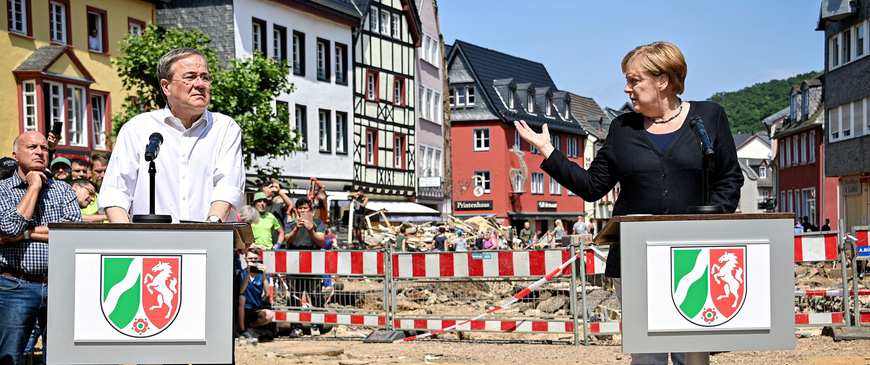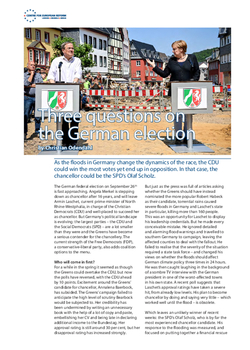
Three questions on the German election
As the floods in Germany change the dynamics of the race, the CDU could win the most votes yet end up in opposition. In that case, the chancellor could be the SPD’s Olaf Scholz.
The German federal election on September 26th is fast approaching. Angela Merkel is stepping down as chancellor after 16 years, and will leave Armin Laschet, current prime minister of North Rhine-Westphalia, in charge of the Christian Democrats (CDU) and well-placed to succeed her as chancellor. But Germany’s political landscape is evolving: the largest parties – the CDU and the Social Democrats (SPD) – are a lot smaller than they were and the Greens have become a serious contender for the chancellery. The current strength of the Free Democrats (FDP), a conservative-liberal party, also adds coalition options to the menu.
Recent floods in Germany have changed the dynamics of the German federal elections. The CDU could win the most votes yet end up in opposition, with the SPD’s Olaf Scholz becoming chancellor.
Who will come in first?
For a while in the spring it seemed as though the Greens could overtake the CDU, but now the polls have reversed, with the CDU ahead by 10 points. Excitement around the Greens’ candidate for chancellor, Annalena Baerbock, has subsided. The Greens’ campaign failed to anticipate the high level of scrutiny Bearbock would be subjected to. Her credibility has been undermined by writing an unnecessary book with the help of a lot of copy and paste, embellishing her CV and being late in declaring additional income to the Bundestag. Her approval rating is still around 30 per cent, but her disapproval rating has increased strongly.
But just as the press was full of articles asking whether the Greens should have instead nominated the more popular Robert Habeck as their candidate, torrential rains caused severe floods in Germany and Laschet’s state in particular, killing more than 160 people. This was an opportunity for Laschet to display his leadership credentials. But he made every conceivable mistake. He ignored detailed and alarming flood warnings and travelled to southern Germany to campaign, leaving the affected counties to deal with the fallout. He failed to realise that the severity of the situation required a state task force – and changed his views on whether the floods should affect German climate policy three times in 24 hours. He was then caught laughing in the background of a sombre TV interview with the German president in one of the worst-affected towns in his own state. A recent poll suggests that Laschet’s approval ratings have taken a severe hit, from already low levels. His plan to become chancellor by doing and saying very little – which worked well until the flood – is obsolete.
Which leaves an unlikely winner of recent weeks: the SPD’s Olaf Scholz, who is by far the most experienced chancellor candidate. His response to the flooding was measured, and focused on putting together a financial rescue package – as would be expected of a finance minister and vice chancellor. Furthermore, his recent successes on the global stage – the G20’s agreement on minimum rates of corporate tax is associated with him in Germany – have added to his standing, relative to his two rivals. The SPD is still well below 20 per cent in the polls, and it is highly unlikely that the SPD will overtake the CDU. But the Social Democrats are within touching distance of the Greens and slowly climbing.
The CDU will probably end up as the largest party, but does that mean that Laschet will become chancellor?
With one exception – Konrad Adenauer governing with an absolute majority after the 1957 elections – post-war Germany has always been ruled by coalitions. The CDU, even when it was the largest party in the Bundestag, has at times still found itself in opposition, for example when the SPD and FDP formed a coalition under the SPD chancellors Willy Brandt and Helmut Schmidt. This election may lead to another instance of this happening.
The most likely outcome is still a CDU-Greens coalition. That is a well-rehearsed combination in several states, both parties are keen to govern and the pressure on their leaderships to come to an agreement after the election would be high. The CDU-Greens coalition would have broadly similar policies to the existing government, but with a stronger green agenda because the Greens would aim to extract concessions from the CDU: a steeper carbon price path in the national scheme, more subsidies for renewables and more public investment in decarbonising transport and buildings.
Another coalition of Greens, SPD and FDP could also have the numbers to govern. This ‘traffic light’ coalition (because the parties’ colours are green, red and yellow) would aim to tackle, at least rhetorically, the three main issues facing Germany: climate change (Greens), social equity (SPD) and the modernisation of its economy and public sector (FDP). However, forming a stable three-party coalition of erstwhile enemies would be tricky: the election platforms of the SPD and Greens on the one side, and the FDP on the other, do not exactly match, with the FDP favouring tax cuts for the rich.
There is another, underappreciated problem of a traffic light coalition: the SPD’s fear of entering the coalition as a junior partner and thus becoming a permanent second fiddle to the Greens. To avoid that, the SPD would put hefty policy demands on the table, such as more generous social benefits or higher taxes on high earners, which would be difficult for the FDP to stomach. An SPD-Green-FDP coalition would only really work if the SPD were larger than the Greens, thus making Scholz the chancellor.
A coalition that would definitely not work, despite pundits outside Germany suggesting it could, is a CDU-SPD-FDP combination. If the SPD entered such a government, dominated by the right, its remaining voters would abandon it in droves.
What does the election mean for Europe?
All the major parties share a strong commitment to the EU, the transatlantic alliance and the euro. Outside Germany, it is often underestimated how strongly Germany’s security and commercial interests anchor the European and international policies of its leaders. EU and NATO membership, for example, are not transactional projects to Germany, but at the core of its national interest. No conceivable CDU chancellor would dissolve the euro or expel one of its members. Nor would a Green chancellor suddenly change course on China fundamentally, despite some hawkish rhetoric, as Germany’s commercial interests are too strong. That is a benefit and a curse at the same time: Europe can count on the next German government to provide stable, predictable leadership; but no conceivable coalition seems willing to challenge voters on their preference for the status quo, like strict fiscal rules and tight monetary policy, aversion to military interventions and limiting confrontation with either Russia or China.
Germany’s next government will be a centrist coalition. This means Europe can count on it to provide stable, predictable leadership, with its European and international policies being a variation of the status quo.
But there are nuances between the possible coalitions which would affect Europe. A traffic light government would be keen to invest in modernising Germany’s economy and public administration. But there would be no way it could fundamentally reform domestic fiscal rules against CDU opposition, since changing the constitution requires two-thirds majorities in both houses of parliament. Tweaking the existing rules is possible, as is circumventing them via special investment funds, but without proper change in Germany, the EU’s fiscal rules will be harder to reform. A CDU-Greens coalition could reform Germany’s fiscal rules to allow for more public investment to fight climate change, setting the tone for something similar at the EU level. Overall, however, the mere fact that Germany’s government will be a centrist coalition means that its European and international policies will be variations of the status quo.
Christian Odendahl is chief economist at the Centre for European Reform.

